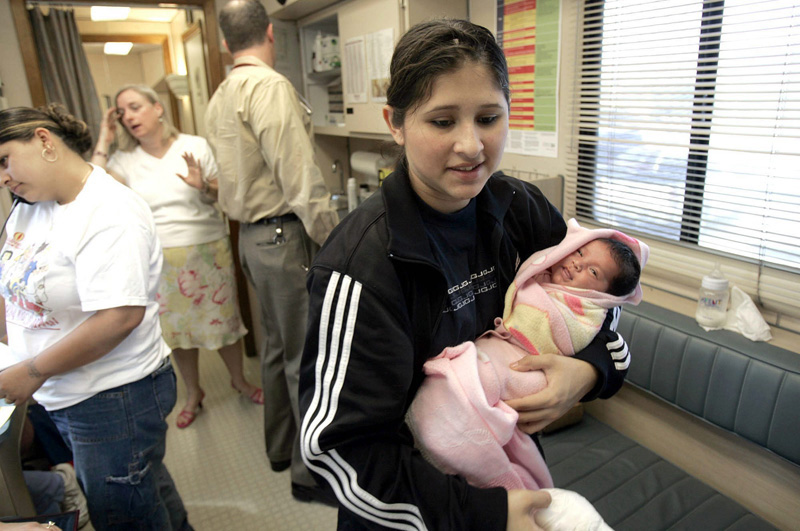It’s one of the most dramatic public health stories of our lifetimes.

A generation ago, across Canada, teen pregnancy rates started to fall. Then they fell some more. Decades later, they’re still falling.
In 2012, about half as many babies were born to Canadian teenagers as were in 1991. (Abortion rates for teenagers also fell — as far as we can tell, there are fewer teen pregnancies.)
Why is it happening? Nobody’s really sure, though there are lots of theories. They range from the obvious (education and birth control) to the less so — high-speed Internet access and, arguably, a decline in lead pollution.
“It’s pretty unclear, and has been for so long,” says Lucia O’Sullivan, a psychologist at the University of New Brunswick in Fredericton.
“In the bigger picture, we still can’t explain it all that well.”
In a recent study, economist Melanie Guldi from the University of Central Florida and a co-author linked falling teen pregnancy rates to the spread of high-speed Internet access, which tends to shift teens’ social lives from the physical to the virtual.
“If you’re not face-to-face, there’s a reduction in sexual activity because of that,” she explains.
(Whether it’s related to online culture or not, U.S. surveys do show fewer high school students being sexually active.)
The Internet also gives teens a chance to learn about birth control with some privacy, she says.
“Teens can ask whatever questions they like on the Internet, ask questions about contraception, about the consequences.”
It’s easy to forget how much less accessible birth control information used to be before widespread Internet access, says Alex McKay, executive director of the Sex Information and Education Council of Canada.
“There was once a time when to find out information about contraception you kind of had to put yourself out there. You had to ask somebody face-to-face about it, or try to get a book from a library. You did sort of expose yourself a little bit as a person who was looking for that kind of information.”
“There was often a kind of stigma attached to that.”
A school of thought connects the decline in lead pollution in the U.S., Canada and other countries to a fall in crime and teen pregnancy rates. The eerie thing, though, is that the fall in crime rates lags the fall in pollution by the lifetime of someone in late adolescence or early adulthood – 17-20 years.
The thinking goes like this: when leaded gasoline was common and air pollution much worse than it is today, infants and toddlers were more likely to be poisoned by lead-contaminated dust in their homes.
Mon, Nov 24: A new program aims to reduce the number of teenage mothers in New Brunswick. The teenage pregnancy rate in the province has reached an alarming and record level. As Global’s Shelley Steeves reports, the program takes a proactive approach.
“By far the most common exposure pathway, is lead in household dust, because the lead in gasoline settled as dust,” economist Rick Nevin explains. “Lead in floor dust is invisible to the naked eye, but we now know that that’s enough to cause neurodevelopmental damage for some children.”
Childhood lead poisoning leads to lowered IQ, and also damages brain development associated with planning and impulse control.
The effect was worse in large cities, which had more vehicle-related pollution.
Nevin traces the start of the decline in U.S. teen pregnancy rates, in about 1990, to the introduction of catalytic converters in cars in the mid-1970s. Catalytic converters, a pollution control device, could not work with leaded gasoline, which forced fuel makers to offer drivers unleaded gasoline. The spread of catalytic converters led to steadily less leaded gasoline being used, which led to less airborne lead pollution affecting small children’s brains, which led to fewer pregnant teenagers – 17 years later.
“This really fits with what we know about more impulsive, reckless, poorly planned behavior in youth and adolescents,” Nevin says. “Your brain, literally, isn’t fully wired.”
- Posters promoting ‘Steal From Loblaws Day’ are circulating. How did we get here?
- Video shows Ontario police sharing Trudeau’s location with protester, investigation launched
- Canadian food banks are on the brink: ‘This is not a sustainable situation’
- Solar eclipse eye damage: More than 160 cases reported in Ontario, Quebec
McKay connects falling teen pregnancy rates to much higher-quality information about sexual health and birth control, both from formal sex education and online.
He also says young women are becoming more confident:
“We’ve been making some fairly dramatic progress in terms of gender equality, and this provides young women with a more equitable power dynamic within their relationships, and that enables them to be much more assertive in determining their own reproductive future.”
McKay expects Canadian teen pregnancy rates to stabilize at about the current level.
“A lot of people have thrown a lot of academic muscle into trying to figure this out, and no one cause has been a real smoking gun,” Guldi says. “One slice is new media. One slice might be expansion of public access to contraception.”
“I don’t think there’s any one cause.”



Comments